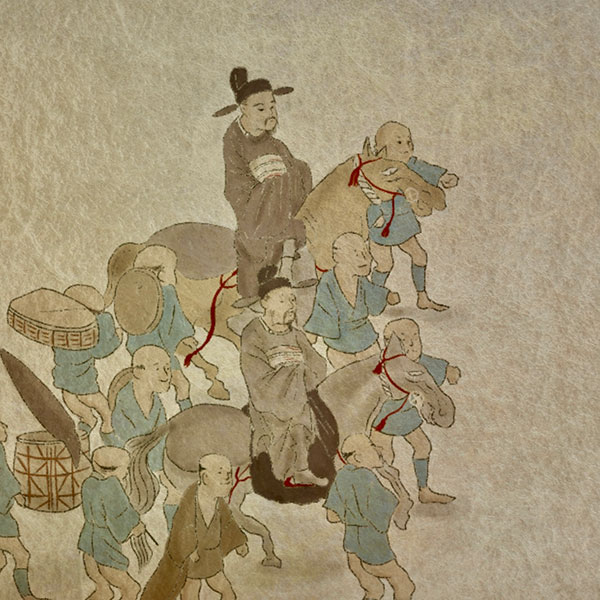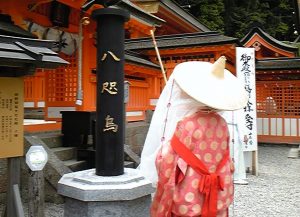The reign of Emperor Shotoku (1/2)Political reform by Arai Hakuseki

The rule of righteousness
- Article category
- case file
- Incident name
- The Shotoku Reign (1709-1716)
- place
- Tokyo
- Related castles, temples and shrines

Edo castle
The Tokugawa Shogunate's finances were on the verge of collapse due to the extravagant spending of the 5th Shogun, Tokugawa Tsunayoshi. In the midst of this, the Confucian scholar Arai Hakuseki, who served the 6th Shogun, Tokugawa Ienobu, and the 7th Shogun, Tokugawa Ietsugu, desperately tried to restore the Shogunate's finances. For seven years, he implemented "civilian government" that placed emphasis on scholarship and Confucianism, and implemented monetary tightening, trade restrictions, and austerity measures to restore the deteriorating finances. This time, we will summarize the government of Shotoku in an easy-to-understand manner.
The finances of the shogunate deteriorated during the reign of Tokugawa Tsunayoshi.
During the reign of the fifth shogun, Tokugawa Tsunayoshi, who was called the "Dog Shogun," the shogunate fell into financial difficulties.Great Fire of MeirekiThe finances of the shogunate were deteriorating due to the cost of rebuilding Edo. Furthermore, the shogunate's main source of income, the mines, were depleted, causing a rapid decline in financial resources. In such a situation, Tsunayoshi, who was a devout man, poured funds into public works such as the construction and renovation of large temples, which further worsened the finances.
Tokugawa Tsunayoshi is also famous for the "Edict to Show Compassion for Living Things," but most of the construction costs of the "dog houses" built to house stray dogs under the Edict were paid by feudal lords, while the costs of raising the dogs were paid by townspeople of Edo and farmers in the surrounding area. These burdens led to a downturn in the economy and caused resentment toward the shogunate.
Originally, the Edict on the Compassion for Living Things was a series of laws issued 135 times, with the main idea being "to take care of all living things." It gradually became stricter and became "the worst law in the world." Immediately after Tsunayoshi's death, the Edict on the Compassion for Living Things was immediately repealed by Tokugawa Ienobu, with the exception of the ban on abandoning children.
Inflation caused by the Shogunate's "currency recoinage"
During the reign of Tokugawa Tsunayoshi, the shogunate carried out a coin recoinage in order to rebuild its finances. This was led by Ogiwara Shigehide, who served as the magistrate of finances, and involved reducing the pure gold and silver content of oval and silver coins and increasing the amount of currency issued.
Previously, Keicho koban (from around 1601) had a gold content of about 84%. Meanwhile, the newly minted Genroku koban had a gold content of about 57%, meaning that two Keicho koban could be used to make three Genroku koban. This recoinage allowed for an increase in revenue of about 5 million ryo, which led to improved finances for the shogunate. Ogiwara Shigehide is known to have said, "Currency is made by the state, so even if we replace it with rubble, this should still be done," meaning that rubble could nominally serve as currency if issued by the state.
The recoinage seemed to have saved the Shogunate's finances, but inflation occurred as the amount of degraded currency in circulation increased. At first, it did not seem to have had much of an impact on the economy, but the Shogunate got a taste for it and continued to recoin currency, which eventually led to dramatic inflation and had a major impact on people's lives. According to one theory, the price of rice rose by an astounding 80% in just four years.
Under these circumstances, the Great Hoei Earthquake occurred on October 4, 1707 (4th year of the Hoei era), measuring an estimated magnitude of 8.6. Forty-nine days later, on November 23, Mount Fuji erupted. The finances of the shogunate and the domains were dealt a major blow by these disasters, and people's lives continued to deteriorate.
The Age of Tokugawa Ienobu: The Appearance of Arai Hakuseki
After Tokugawa Tsunayoshi died of illness on January 10, 1709 (6th year of the Hoei era), Tokugawa Iemitsu's grandson, Tokugawa Ienobu, became the 6th shogun. As Tsunayoshi had no male heir, Ienobu, who took over at the age of 48, placed great value on two of his close aides. One was chamberlain Mabe Akifusa, and the other was Arai Hakuseki, a zaiko (scholar who lectured the monarch on academic subjects) who served as a sort of political advisor. Arai Hakuseki was the key person in the "Shotoku Reign."
Arai Hakuseki was born on February 10, 1657 (Meireki 3), about one month after the Great Fire of Meireki, in Yanagiwara, Edo (present-day Adachi Ward, Tokyo), where his father had taken refuge. He is said to have been a "child prodigy," having copied out his father's Confucian texts at the age of three and pointing out unclear points in the Taiheiki at the age of four. He had a fiery temper, and when he got angry, wrinkles would appear between his eyebrows in the shape of the character for fire, which is why Tsuchiya Toshinao, the lord of Kururi (present-day Kimitsu City, Chiba Prefecture), where his father served, loved him and nicknamed him "child of fire."
However, as a result of internal conflict following the death of Toshinao Tsuchiya, Arai Hakuseki and his father were banished from the domain. The Arai family fell into poverty, but Shiraishi, despite his poverty, continued to study Confucianism and history. He served the chief advisor, Hotta Masatoshi, for a time, but when Hotta Masatoshi was assassinated by Inaba Masayasu, the Hotta family fell into decline and Shiraishi became a ronin (masterless samurai).
Later, Arai Hakuseki became a disciple of Kinoshita Junan, a Confucian scholar who was the teacher of Tokugawa Tsunayoshi, and distinguished himself there. With Junan's recommendation, he served the Kofu Domain (Kuninaka region, Yamanashi Prefecture), whose lord was Tokugawa Tsunatoyo, later known as Tokugawa Ienobu. Over a period of 19 years, Hakuseki gave 1,299 lectures to Tsunatoyo, who loved learning and attended every lecture in full dress.
When Tokugawa Ienobu became Shogun, Arai Hakuseki entered politics. Shiraishi aimed to shift the country from the "military government" that was based on military force in the early Edo Shogunate to a "civil government" that emphasized Confucianism, encouraged learning and education, and governed through education and laws. The shift to civil government had been underway since the time of the fourth Shogun, Tokugawa Ietsuna, but it reached its peak during the time of Arai Hakuseki.
The Shotoku Era: Part 1: The Dispute over Recoinage, Ogiwara Shigehide vs. Arai Hakuseki
Now, let's take a look at the main initiatives of the "Shotoku Reign" led by Arai Hakuseki. Arai Hakuseki implemented currency reform as a fiscal policy. However, unlike Ogiwara Shigehide, he increased the gold and silver content (purity) to improve the quality of currency.
Even after Tokugawa Ienobu succeeded him as Shogun, Ogiwara Shigehide remained in his position as Finance Magistrate. When Ienobu asked Shigehide about financial reconstruction, Shigehide called for further re-minting of currency. Arai Hakuseki was strongly opposed to this. As a result, Shigehide created the "Hōei koban" in 1710 (7th year of the Hōei era), which had a higher gold content to 84%, the same as the Keicho koban. However, this koban was half the size of the Keicho koban. Shigehide did as Hakuseki suggested and returned the gold content to the same level as the Keicho koban, but he was adamant that the amount of gold used was not changed.
Furthermore, Shigehide Ogiwara exchanged silver coins without the Shogun's approval, lowering the silver content, and "bad silver" such as Mitsuho silver and Yotsuho silver flooded the market. The economy was in turmoil, and various recoinages led to further inflation.
Angered by this turn of events, Arai Hakuseki appealed to Ienobu to dismiss Ogiwara Shigehide, claiming that the recoinage by Ogiwara Shigehide had undermined the authority of the shogunate. He claimed that Shigehide had profited illegally from the recoinage (the truth of this is unknown), and when his opinion was not accepted, he was willing to kill himself in order to bring Shigehide down. In 1712 (the 2nd year of Shotoku), Ienobu, who was on his sickbed, finally accepted Shiraishi's third letter of impeachment and dismissed Shigehide.
The Shotoku Era: Success or Failure? Recoinage to Increase Quality
In October 1712, Tokugawa Ienobu died just three years after becoming Shogun. He was succeeded by the 5-year-old Tokugawa Ietsugu as the 7th Shogun. After he became Shogun in April 1713, the government was continued to be run by the duo of chamberlain Hamanaka Akifusa and political advisor Arai Hakuseki.
With Ogiwara Shigehide no longer an obstacle, Arai Hakuseki followed Tokugawa Ieyasu's words that "currency should be made from respected materials" and in 1714 (the 4th year of the Shotoku era), he started circulating "Shotoku koban" coins, which had the same fineness and weight as the Keicho koban, with a fineness of about 84% and a weight of 18g. He also tried to calm inflation by producing high-quality silver coins of similar fineness and reducing the amount of currency.
Arai Hakuseki himself recommended that it be gradually replaced over a period of 20 years or more, as reducing the amount of currency by recoining a large amount at once would have a negative impact on the economy. In fact, the amount of recoinage during the Shotoku period was not that large, with a total of about 210,000 ryo of Shotoku koban and ichibu gold coins. This was less than 1% of the amount of Genroku koban, Hoei koban, etc. issued. However, in 1714 (the 4th year of the Shotoku period), the Kyoho koban, which had a gold content of about 87%, appeared, and reached 8.28 million ryo, causing deflation and economic activity to stagnate.
The economic policies of Ogiwara Shigehide and Arai Hakuseki are both controversial, with historians and economists offering various opinions. If you are interested, I encourage you to do some research.
The Shōtoku Era: 3. Contraction of trade with Nagasaki
One of the important policies implemented by Arai Hakuseki was the reduction of trade in Nagasaki. During the time of Tokugawa Ienobu, Japan was under the so-called "national isolation" policy, and its access points to the outside world were limited to the "four gateways": Nagasaki, Satsuma, Tsushima, and Matsumae (Ezo). Of these, trade with the Netherlands and China (Qing) was conducted through the Nagasaki gateway under the direct control of the Nagasaki Magistrate, who was under the direct control of the shogunate.

- WriterNaoko Kurimoto(Writer)I am a former travel industry magazine reporter. I have loved history, both Japanese and world history, since I was a child. I usually enjoy visiting temples and shrines, especially shrines, and often do ``pilgrimages to sacred places'' themed around historical figures. My favorite military commander is Ishida Mitsunari, my favorite castle is Kumamoto Castle, and my favorite castle ruins is Hagi Castle. My heart flutters when I see the ruins of battle castles and the stone walls of castle ruins.



